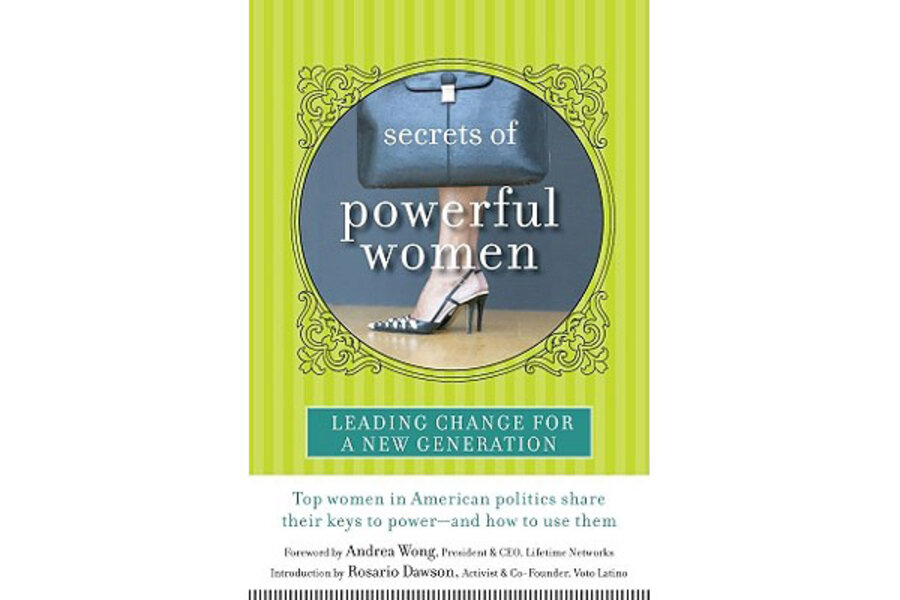Secrets of Powerful Women
Loading...
What helps a woman to succeed? Sixteen teenage girls asked that question of some of the most powerful women in America. Here’s what they heard: Nurture your relationships. Share the credit. Seize the moment. Do not wait to be asked about taking power.
Because, as California congresswoman Loretta Sanchez put it, “Life is not a fairy tale, and that prince ain’t coming.”
The new book Secrets of Powerful Women champions female networks to help young women realize their ability to lead.
The idea for the book took root after women leaders in American politics spoke to 16 teenage girls who had won an essay contest cosponsored by Lifetime in 2008. Lifetime asked these female powerhouses to turn their remarks into essays for a book. Andrea Wong, president and CEO of Lifetime Networks, explains why in the book’s foreword: “[I]f we are ever going to crash through that ceiling altogether, it’s not enough to let only a handful of women at a time in on the secrets.”
The contributors reveal why and how women help other women, whether in groups or one-on-one. As Sanchez explains, growing “our network of girlfriends” in Congress enables women to be effective in office. A critical mass of women in leadership positions across sectors is essential to “change the way this country works,” writes Marie Wilson, president of The White House Project, which expects to have prepared more than 40,000 women to run for office by 2013.
Wilson, Sanchez, and Wong are three of the 24 female activists, journalists, and members of Congress from different races, parties, and places who contribute to the book and cheer women on to lead.
In essays that at times take a pep-talk tone, women leaders talk about being influenced by strong mothers and grandmothers who defied convention by working outside the home and getting college educations before it was widely accepted. It helped when fathers supported mothers’ endeavors. Beyond families, the women pointed to Betty Friedan, Gloria Steinem, and Margaret Thatcher as role models.
But where the women really spill secrets is in their personal narratives. Lisa Maatz, a lobbyist for the American Association of University Women, learned about lobbying and grass-roots organizing at age 8. Maatz describes politely asking the school principal, Mr. Ginke, for doors to the stalls in the girls’ bathroom. The boys had doors, she argued. Maatz remembers the principal patting her on the head and dismissing her request. “[W]hen I gave Mr. Ginke a petition signed by two hundred of my classmates, I had doors in a week,” she writes.
For Rep. Jan Schakowsky (D) of Illinois, a career in politics began organically. At 25, she was part of a group of six suburban housewives that called themselves National Consumers United. Their mission: to know how old the grocery food was that they were buying. They inspected stores and found food was on the shelves long after the date manufacturers said it was fresh. After becoming small shareholders of the Jewel supermarket chain and the National Tea Company, the women wrote press releases about their work. “We won!” Schakowsky writes. “Jewel began to advertise ‘freshness dates.’ ” Schakowsky says that early taste of making a difference led her to take other advocacy jobs, and eventually to run for Congress.
So far, the contributors are part of a small group of women leaders, and the statistics they reiterate through the book provide good context for their stories. Women make up 17 percent of congressional seats, 7 governorships, and 24 percent of state legislatures. They run 3 percent of the Fortune 500 companies, and occupy 3 percent of top positions in the media industry.
The women are skilled at explaining why the low numbers matter. Different perspectives are needed to create good policies, says Shelley Moore Capito (R) of West Virginia. Women also bring in new voices, work well in teams, and seek out long-term solutions, writes Rep. Kay Granger (R) of Texas.
Such realistic views carry over to thoughts about women’s personal styles. In the recurring section Power Dressing, it’s refreshing to find successful women getting real about the significance of their clothing choices. Betsy Myers, a senior adviser to Barack Obama’s presidential campaign, recalls watching bright, attractive women being sidelined because of “inappropriate clothes.” The late Ann Richards, former governor of Texas, once told Granger to ditch her navy blue suit and wear bright colors to stand out in a crowd. Granger’s power attire now: a red suit.
For all the focus on women, the contributors neither demean men nor debate which gender leads better. Rather, Schakowsky says “investing in women” helps “create a more peaceful, more healthful, more productive society.” The takeaway message to women is confident: Everyone benefits when more women lead and this is why they must.
Ari Pinkus is a graduate student in management at New York University.





